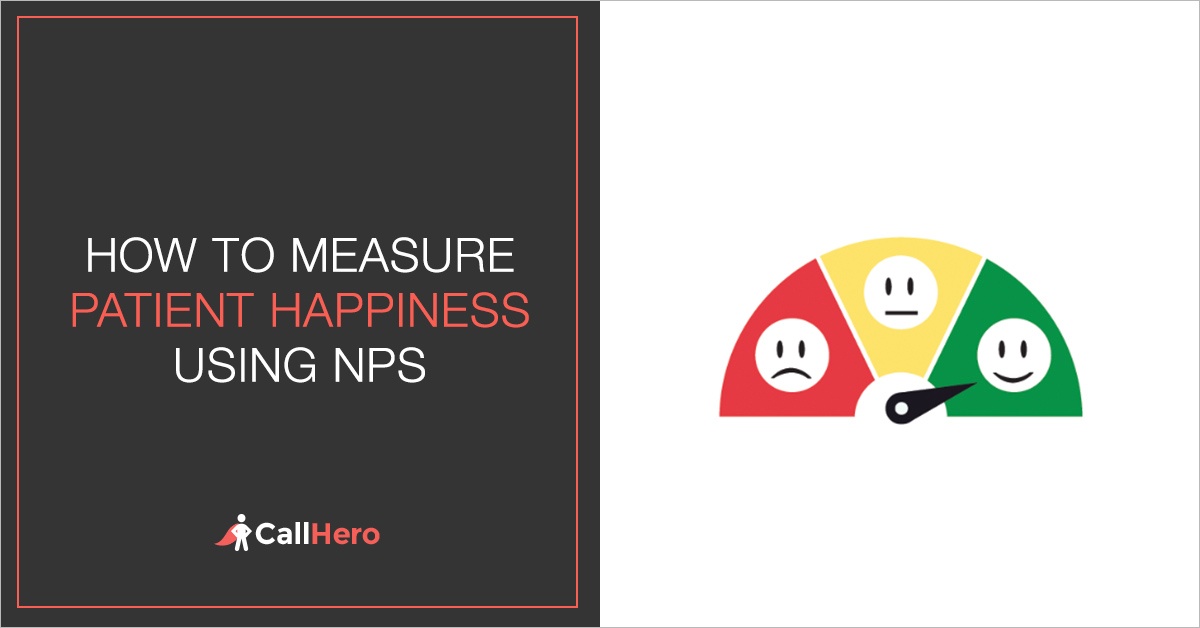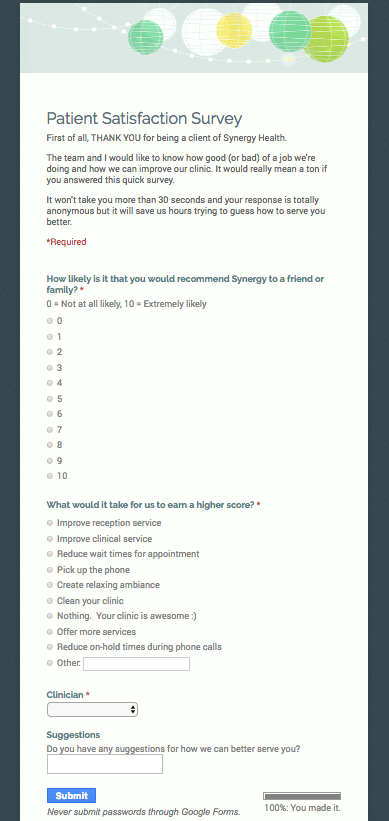
Happy satisfied patients. That’s what any clinic owner wants.
But, do you actually know how happy and satisfied your patients really are?
It wouldn’t come as a surprise if you said: “I think my patients are happy but I haven’t measured it.”
What you measure you can manage. Not only that, when you measure, you can use the results to fix problems and drive better clinical performance.
Thankfully, there is a great tool for measuring patient happiness: The Net Promoter Score, otherwise known as NPS.
NPS can be used to measure overall patient satisfaction. It can be used to identify unhappy customers at each point of the patient journey. It can also be used to identify your biggest fans so you can ask them for referrals or google reviews.
The data you collect from NPS is essential to running an optimized practice.
In this post, you’ll learn:
- How to use the NPS to boost your clinical operations
- How to calculate your Net Promoter Score
- What does the NPS score mean
- The NPS template I use for my private clients
Developed by Fred Reichheld, the Net Promoter Score (NPS) measures the loyalty that exists between your patients and your clinic.
According to Strive Labs, the benefits businesses see from gathering NPS are:
- Increases in their number of word-of-mouth referrals
- Increases in their customer retention rate (decreased early patient dropout)
- Increases in customer reactivation rate (getting past patients to come back)
- Implementation of data-driven process changes across their organizations to improve the customer experience and systematically build patient loyalty
As you can see, used right, NPS can really give you powerful metrics to help drive your business forward.
What is NPS?
In a simple survey, NPS asks your patients the question:
How likely is it that you would recommend [clinic name] to a friend, family or colleague?
It often looks like this:

You’ve probably seen these used by various businesses yourself.
Patients respond to this question on a zero to 10 point rating scale.
The NPS divides your patients into three categories:
Promoters (score 9 - 10): Loyal patients who will keep coming to your clinic and refer others (aka Word of Mouth Marketing).
Passives (score 7 - 8): Satisfied but not enthusiastic patients who are susceptible to competitive offers. Passives only count towards the total number of respondents and does not directly affect the score.
Detractors (score 0 - 6): Unhappy patients who can damage your brand through negative word of mouth.
Get your Ultimate Phone Training Guide
The Phone Lady Reveals 23 Killer Secrets. CLICK HERE to download
How to Calculate Your NPS Score
Your NPS score is calculated by the following formula:
NPS = (% of Promoters) - (% of Detractors)
Often you don’t have to do this yourself as there are plenty of survey platforms you can use to collect surveys for free. I recommend using google forms.
You simply set up the survey, then embed it in an email or send the link to your customers. Or alternatively, you can put the survey on an IPAD and get patients to fillout after their visit.
Here is the IPAD template I use for my private clients

What does the NPS score mean?
The NPS can be as high as +100 (everybody is a promoter) or as low as -100 (everybody is a detractor). The higher the NPS, the more likely your patients will recommend your clinic to others.
- You’re in the top 10% if your score is in the 80s
- You’re average if your score is in the mid 50s to 70s
- And you’ve got a bit of work to do if your score is below 50, you’re in the bottom 10%
NPS is more than a numbers game. As a clinic owner, you can’t take action if you don’t know why a patient is or is not “likely to recommend.”
You see, the NPS is much more than just a survey. It is a valuable operational metric about how strong (or weak) your clinical teams are and what you need to do to improve.
Always follow up the NPS survey with an open-ended question like: "What would it take for us to earn a higher score?" or "Do you have any suggestions for how we can serve you better?"
You can't fix what you don't know so always ask for more information.
When and where to use NPS
Directly after the first patient appointment, get your front desk staff to give your patients the NPS survey.
“Based on your treatment and the service we provided today, how likely are you to recommend {Clinc Name} to a friend, colleague or family member?”
Get the patient to fill out the survey before they leave. Ensure that the form has the client’s name so you can measure NPS by client. And keep track of everything on a google spreadsheet.
Next, send an email on Net Promoter Score to every patient at day 1, week 4 and discharge.
By delivering the NPS at key points of care, you’re able to see patterns emerge that can help you access if your service is staying on point. Or more importantly, address issues with patients if they arise. Identifying patient dissatisfaction points can help reduce customer drop out rates, which saves you money over time.
It's much easier and less costly to keep a customer you already have than to acquire a new one.
Of course, you need a plan to deal with a low score so strategize your communications before this happens. For instance, will your clinician (or clinic manager) call a patient with a low score and ask them for more information and how you can fix it?
Put systems in place to ensure you utilize the data you collect, and keep patient happy.
Identify your top promoters, the ones giving you 9-10 scores and ask them for Google reviews or testimonials.
NPS Patient Email Example
Use an email template such as the following to obtain patient's score.
|
[Hi FirstName] First of all, thank you for being a patient of [Clincian Name] at [Clinic Name]. The team and I would love to know how good (or bad) of a job we’re doing and how we can improve what we offer at [Clinic Name]. It would really mean a lot if you could take this short 30 second survey:
Thanks for your valuable time to help us save hours trying to guess how to serve you better. We appreciate you. Signature |
When the customer clicks on a number answering the survey, you can set the email to redirect them to a form where they can give you more information on how to improve your NPS score by answering two quick questions:
- What would it take for us to earn a higher score?
- Do you have any suggestions for how we can serve you better?
On first impressions, NPS seems very simple. But when used right, it can provide critical data to help you improve your clinical operations.





